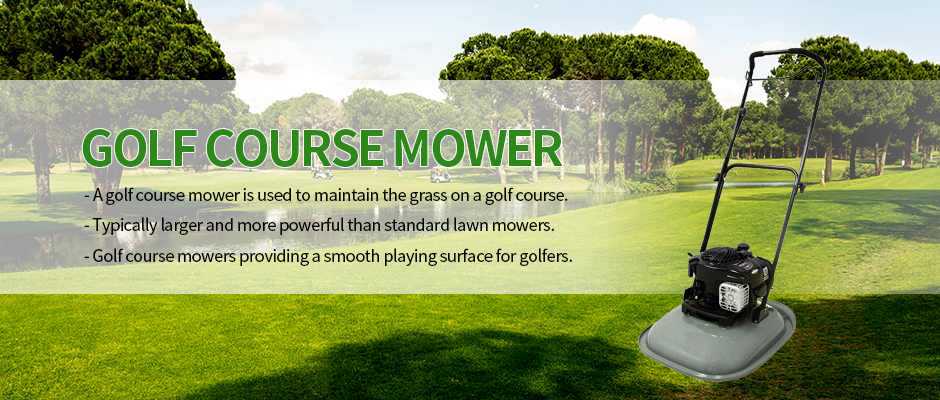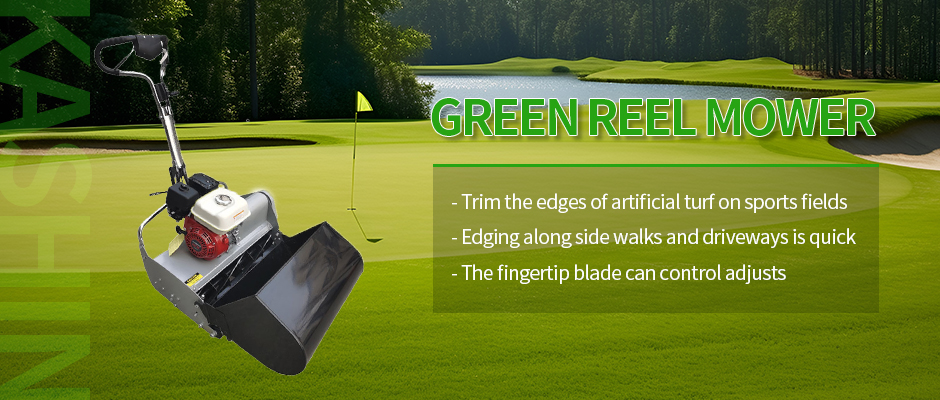Lawn mowing is one of the daily maintenance of lawn. It has the functions of controlling the height of lawn grass, improving the activity of lawn root system, improving the elasticity and smoothness of lawn. Lawn mowing should be based on the biological characteristics of the lawn grass and master the correct mowing method to maintain the neatness and ornamental effect of the lawn. Improper mowing will cause the lawn to weaken, or cause the occurrence of diseases, insect pests and weeds.
Lawn mowing height
Lawn mowing height is also called stubble height, which refers to the vertical height of branches on the ground after lawn mowing. Different turfgrasses tolerate different mowing heights due to their different biological characteristics.
For example, creeping bentgrass has well-developed stolons and can tolerate mowing heights of 0.5cm or even lower, so it is often used in golf putting greens. Tall fescue and bluegrass that grow upright need to be pruned at a height higher than 2.5cm, and are generally intolerant of low pruning. Zoysia, bermudagrass, etc. grow creeping on the ground and have low growth points, so the pruning height can be appropriately reduced. The suitable mowing height for most lawns is 3~4cm.
When mowing lawns, you should follow the 1/3 principle. For taller lawns, you cannot cut them to the required height at one time. When mowing, cut off 1/3 of the leaves so that the remaining leaves can perform photosynthesis normally. Cut again after three days. If you mow too much at one time, the above-ground part will not be able to provide enough assimilation products for the root system, hindering the growth of the root system, and the lawn will die due to lack of nutrients. If the lawn is growing too vigorously, the mowing height should be raised as much as possible, and then pruned at the normal mowing height after three or four days to avoid excessive pruning of mature leaves, and the lower leaves that have adapted to the shade environment are suddenly exposed to the sun, causing the leaves to grow. burns.
The harm caused by improper mowing to the lawn:
The height of turfgrass is directly related to the depth of its root system. If the mowing is too low, the root system will become shallower accordingly. Therefore, the lawn is more susceptible to drought stress. Similarly, if the mowing is too low, it will also cause maintenance difficulties. Under low mowing conditions, weed seeds in the soil will get more light, and the weeds will Seedlings also get better growing conditions, which can lead to weed damage.
Mowing too high can also have a negative impact on your lawn. A lawn that is too high is not only unsightly, but also reduces the ornamental value of the lawn. In particular, it causes the grass to be thin, reduces the tillering ability, and even causes the occurrence of diseases and insect pests.
Lawn mowing methods
Depending on the mowing direction, the orientation and reflection of the lawn stems and leaves are also different, resulting in alternating light and dark strips like those seen in many stadiums. However, repeated mowing in the same direction multiple times at the same location will cause the grass blades to deviate. Growing in the same direction will cause the lawn to grow unevenly and weaken the lawn grass growth. The cutting direction should be changed during mowing to prevent the lawnmower from cutting in the same direction and compacting the soil. This can also ensure the upright growth of the lawn grass and maintain a relatively consistent cutting surface after mowing. Finally, you can make fine cuts at an angle of 45° or 90° to the initial cutting direction to ensure more even trimming.
Lawn mowing frequency
How often you need to mow your lawn grass depends on how fast your lawn grass grows. Cool-season lawns generally grow faster and are mowed more often in the spring and fall, while growing slower and mowing less frequently in the summer. Warm-season lawns grow faster in the summer, grow more slowly in the spring and autumn, and mow less frequently. Regardless of whether it is a cool-season grass or a warm-season grass, the root system grows slowly in colder climates, and its activity is reduced, and it cannot provide necessary nutrients for the above-ground parts. Therefore, when pruning, the lower limit of the appropriate pruning height should be used to reduce Consumption of nutrients by aboveground parts. Therefore, the lawn entering winter should be mowed lower than the normal mowing height, so that the lawn can turn green early next year.
Grass clippings treatment
The trimmed grass clippings are left on the lawn. Although they can return the nutrients in the grass clippings to the lawn, improve drought conditions and prevent the growth of moss, they should usually be cleaned up in time. Otherwise, the accumulation of grass clippings on the lawn will not only damage the lawn but also cause damage to the lawn. It looks unsightly, and will weaken the growth of the lawn grass in the lower part due to insufficient light and ventilation. The grass clippings left behind are also conducive to the breeding of weeds and can easily cause the spread of diseases and insect pests. Under normal circumstances, grass clippings should be cleaned up in time after each mowing. However, under high temperature conditions, if the lawn itself grows healthily and no disease occurs, the grass clippings can also be left on the surface of the lawn to reduce soil water evaporation.
Notes on lawn mowing:
1. The blade’s sharp operating speed can cut the grass completely. Therefore, it is necessary to use a large throttle when working to keep the engine at maximum speed. If the engine speed drops, check whether the blade is bitten and adjust the cutting to be narrower or the forward speed to be lower.
2. Choose a sunny or dry environment to cut the lawn to reduce the chance of spreading germs; in hot and rainy seasons, spray lawn preventive fungicides in a timely manner after pruning is completed to prevent and treat bacterial infections.
3. On shaded lawns, the mowing height of lawn grass should be the upper limit of the recommended mowing height range, so that more leaves can be maintained on the ground, more light can be obtained, and the root system can be ensured to have high vitality.
4. When the lawn is under environmental stress, the mowing height should be appropriately increased to increase the stress resistance of the lawn. For example, in the cold season, the mowing height should be increased during periods of high temperature and humidity; when the lawn returns to green from dormancy, the mowing height can be appropriately lowered to remove some dead tissue and allow direct sunlight to shine on new plants and soil, promoting their rapid greening. grow.
Post time: Jun-12-2024


